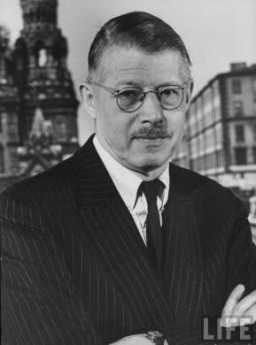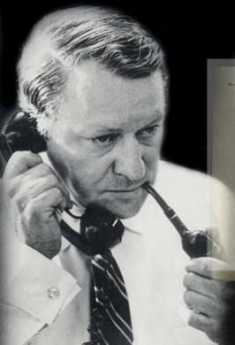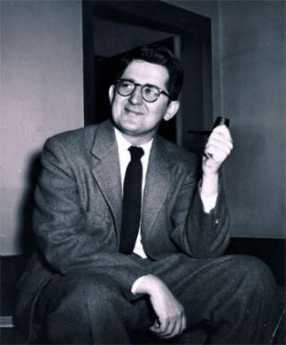Related Topics
Franklin Inn Club
Hidden in a back alley near the theaters, this little club is the center of the City's literary circle. It enjoys outstanding food in surroundings which suggest Samuel Johnson's club in London.
Old Age, Re-designed
A grumpy analysis of future trends from a member of the Grumpy Generation.
The News of Ideas

|
| Harrison Salisbury |
Children, if they read a newspaper at all, dive right into the comic pages. Retirees and other older people with time for reflection, go straight to the Op-Ed page. Although columnists and feature writers have occasionally appeared opposite the editorials in the past century, the Op(posite)-Ed(itorial) page as it now has become standardized in metropolitan newspapers, was started in the New York Times in 1970. The leaders of that paper had been wrangling and debating the issue for at least six years, so a great many people now take credit for it. The publisher, Punch Sulzberger, made the final decision to go ahead with it, and Harrison Salisbury as the first editor of the page had a lot to do with shaping it. The most vociferous advocate for the Op-Ed concept was John B. Oakes. The concept would never have succeeded without the enthusiasm of these three men. However, a lot of articulate people sit around the offices of the paper, and the concepts which eventually emerged had a lot to do with the opinions and indirect influence of Scotty Reston and Abe Rosenthal. What in the world was at stake that such a simple idea took so long to emerge?
 The Editorial page and the Op-Ed pages are the heart of a newspaper for senior citizens. 
|
Newspapers generally, and the Times in particular, make a great fuss about keeping the editorial and news departments independent of each other. The news department is supposed to report the facts fairly and without coloration by the writer's opinion. It might well be imagined that these well-informed articulate people are constantly itching to express their deeply held beliefs, and convince the world to change its views; that's forbidden. Things are carried to the point where the authors of news stories are not permitted to write their own headlines; sometimes the headlines and the content appear to conflict with each other. The underlying purpose of this isolation is to discourage advertisers from influencing the coverage of their topic. In small-town newspapers it is often true that the paper will not write a story about a business unless it is accompanied by the order for an ad; not so, at the Times. All the News That's Fit to Print, is their claim; all the news that fits, mutter their competitors.

|
| James "Scotty" Reston |
The news department is told that opinions are expressed by the Editorial Department. Send them a memo if you want to get our opinion published, but keep it out of your news reports. The Editorial department is held to following the opinions of the newspaper owner in some papers; the Times asserts it excludes even the owner of the paper from its meetings of the editorial boards, This wrangle, some would say hypocrisy, influences a number of publications to a variable degree. Every editorial candidate is expected to demand that his contract include some reference to editorial autonomy, and is expected to resign in a public huff if the owner sticks his nose where it isn't welcome. In turn, the editor has control of hiring the subordinates and making assignments, prerogatives which the owner must not infringe. But it is clear that someone with expressed views repugnant to the owner is not going to get hired, and they all are careful to be well informed about the degree of the owner's interest in matters. For the most part, owners are too busy with other matters to pay much attention to the editorial slant, but they are certainly always at least to be regarded as sleeping tigers.
With this brief summary, it can be seen that both the news and the editorial departments are to some degree just aching to come right out and publish their unvarnished opinion, and from different angles are always under the constraint to tone it down. So, when the idea of an Op-Ed page comes up, both the news and the editorial groups want very much to control it. In this case, the editorial side won the argument, when Punch Sulzberger awarded it to them; and a number of representatives from the news side of the paper felt their enthusiasm cool. But the mission statement was created by Reston, who convinced people that what was sorely lacking in all newspapers was some discussion of the news of ideas. That's a compromise both sides could live with, and it also happened to be true. Up until that time, there was no established place for discussion of ideas.

|
| Abe Rosenthal |
It would have to be admitted that the Wall Street Journal comes closer to fulfilling that mission than the paper which originated it. The reason can be surmised to originate in the hiring policies. As space in the paper becomes constrained by economics, the Times has tended to hang on to its full-time employees, or others who have long-term contracts. No matter how big your payroll or how large your staff, this tends to narrow the range of opinion. In fact, with constrained space but a large staff, it makes things worse. By either intent or financial necessity, other papers have sought out many more occasional opinions from stringers and specialists in the topic of the day. The Wall Street Journal has carried this idea farthest. They appear to hunt up Nobel Prize winners, Presidential cabinet members, corporation chairmen, prominent jurists, and others who would have to be acknowledged as experts in a particular topic. True, there are a couple of regular columnists, and it's also true that the Times is starting to tend in that direction. It would look as though Democrat administrations feed articles to the Times while Republican administrations try to use the voice of the Journal to announce their positions. And from time to time, the parties switch papers, in a bipartisan way, as the expression goes. But the Journal is going further, faster; they now print three pages of editorials, while the Times stays with two. Pages without ads cost money, but that makes them an ideal way to flaunt success with readers.
And back in the 1960s when all this was being debated, very little was expressed in just this way. At that time, the Times had the quaint custom of printing the obituaries opposite the editorials. The two battling contenders to present the news of ideas spent most of their time refusing to move the obits.
Originally published: Wednesday, July 01, 2009; most-recently modified: Friday, June 07, 2019